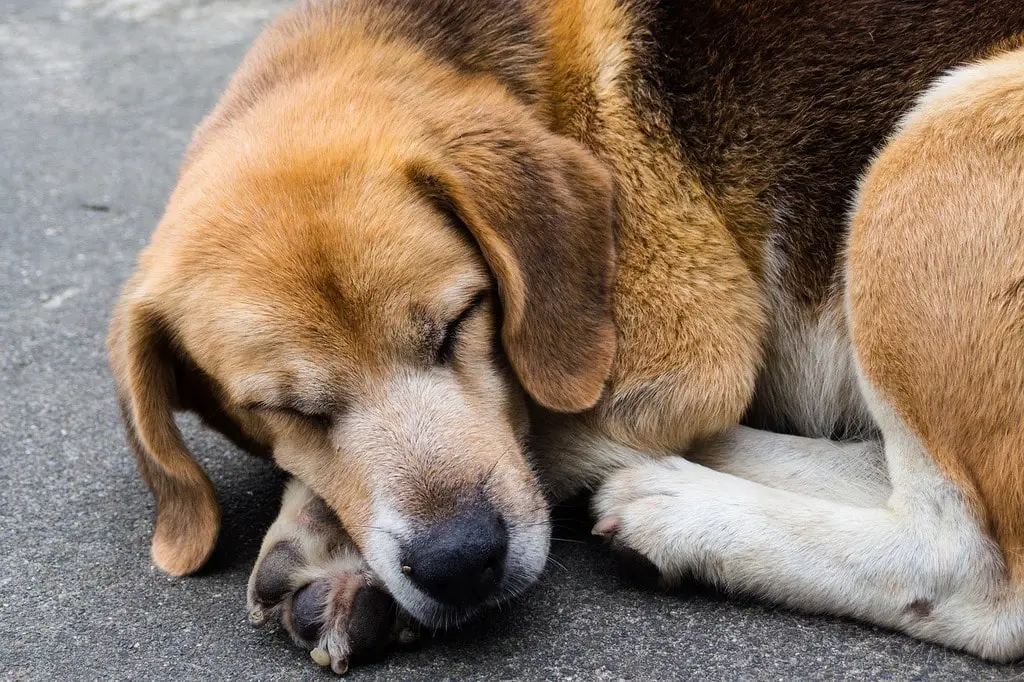Although an uncommon occurrence, there are times you can experience a temporary inability to move directly after falling asleep or right before waking up. As you watch your dog run in their sleep or yelp and jerk around, you may wonder if they are dreaming or if your dog can suffer from sleep paralysis.
While dogs do experience muscle paralysis during sleep, it would appear that our dogs have escaped the distressing sleep condition of sleep paralysis where the sleeper regains consciousness while the muscles are still paralyzed. Sleep paralysis is linked to sleep deprivation, and dogs almost never suffer from sleep deprivation.
This article will examine what sleep paralysis is, look at the different sleep stages, and evaluate whether dogs experience paralysis during sleep or other sleep disturbances and why.
What Is Sleep Paralysis?

Some sleep traits and sleep disorders are the same for dogs as for humans. The definition of sleep paralysis is a type of parasomnia, which is abnormal behavior during sleep involving a mixed state of consciousness.
It is characterized by brief episodes of atonia, which is a loss of muscle control. It usually happens directly after falling asleep or immediately before waking. It is frequently accompanied by feelings of suffocation and hallucinations (source).
REM (rapid eye movement) sleep is characterized by vivid dreaming, and sleep paralysis is connected to this REM cycle. Some form of atonia prevents us from acting out our dreams. During sleep paralysis, the person is awake and aware of the atonia.
Hallucinations can be of the vestibular-motor type, which includes out-of-body sensations or movement such as flying, intruder hallucinations — creating the sensation of a dangerous presence in the room — or the chest pressure type (incubus) that creates the feeling of suffocation.
Episodes last from a few seconds to 20 minutes, and about 75% feature hallucinations. Few of the hallucinations are pleasant.
For more on dog sleep issues, read our article, “Can Dogs Have Night Terrors?”
People and dogs dream during REM and non-REM sleep. However, in non-REM sleep, the dreams are quite mundane and are not often recalled.
Researchers have been looking into the learning and consolidation of memories during dream cycles, and they reported people are more likely to awaken during REM cycles when their dreams are vivid and bizarre (source).
REM sleep is shorter in dogs; they do dream but spend less time in the REM cycle, meaning less time for such vivid dreams.
Types of Sleep Paralysis
In general, sleep paralysis can be isolated or recurrent. Suppose the episodes are not connected to an underlying condition like narcolepsy. In that case, they are considered isolated, whereas recurrent episodes involve multiple instances, known as recurrent isolated sleep paralysis (RISP).
What Are the Dog Sleep Stages?
Dogs have the same sleep stages that humans do, namely short-wave sleep (SWS) and rapid eye movement (REM) sleep. When dogs dream, you’ll often see rapid eye movement (source).
Dogs sleep for approximately half of their day. They are active for only about 20% of the remaining time and relaxed for the other 30%. Dogs enter REM sleep shortly after falling asleep, taking about 10 minutes to enter REM sleep.
During the slow-wave stage, their heart rate and breathing decrease, and there is also a drop in blood pressure. Humans, on average, spend about 25% of their sleeping time in REM sleep. However, because dogs doze on and off, they need considerably more total sleep than humans.
Dreaming is the body’s way of processing memories. You will often see your dogs twitching, air running, or yelping in their sleep.
Do Dogs Experience Muscle Paralysis During Sleep?
A dog dreams in similar patterns to the way humans do. They enter REM sleep very soon after falling asleep, around 10 to 20 minutes, and you may notice twitching, especially in puppies or older dogs where the pons does not function properly (source).
The pons structure in the brainstem is responsible for paralyzing the large muscles during sleep to keep dogs from acting out their dreams. In sleep paralysis, consciousness returns before the muscle paralysis lifts.
Dr. Stanley Coren is Professor Emeritus of Psychology at the University of British Columbia and the author of Do Dogs Dream? Nearly Everything Your Dog Wants You to Know. He noted that dogs probably escape the human condition of sleep paralysis, which is intricately linked to sleep deprivation.
As dogs tend to sleep whenever they feel like it, they hardly ever suffer from sleep deprivation.
A study published in the Journal of Physiological Behavior in 1977 found that dogs only spend about 12% of their time in REM sleep because they slept so often. Their slow-wave sleep was also higher than that of humans at around 23% (source).
Narcolepsy and Cataplexy
Both narcolepsy and cataplexy are neurological disorders that affect sleep and sleep patterns. Dogs may suffer from both narcolepsy and cataplexy, and both are relatively common occurrences. Narcolepsy is generally related to fleeting episodes.
Narcolepsy causes brief losses of consciousness, excessive sleepiness in the daytime, lack of energy, and the brain literally falling into sudden sleep. The episodes are brief and spontaneous, much like cataplexy.
Cataplexy refers to sudden atonia (muscle paralysis) (source), where the dog remains alert and can follow your movements throughout the episode, which are brief, spontaneous, and reversible.
In humans, sleep paralysis is linked to the underlying condition of narcolepsy.
Final Thoughts
Dogs experience sleep patterns very similar to those of humans. However, their REM sleep is shorter, and they dream about everyday activities such as chasing a squirrel.
According to the studies referenced above, dogs may suffer from narcolepsy and cataplexy. They will experience muscle paralysis during sleep, but luckily they do not seem to experience sleep paralysis, which is linked to sleep deprivation.
Escaping sleep paralysis is a blessing for our furry friends, as the hallucinations that accompany sleep paralysis can be petrifying.



0 Comments